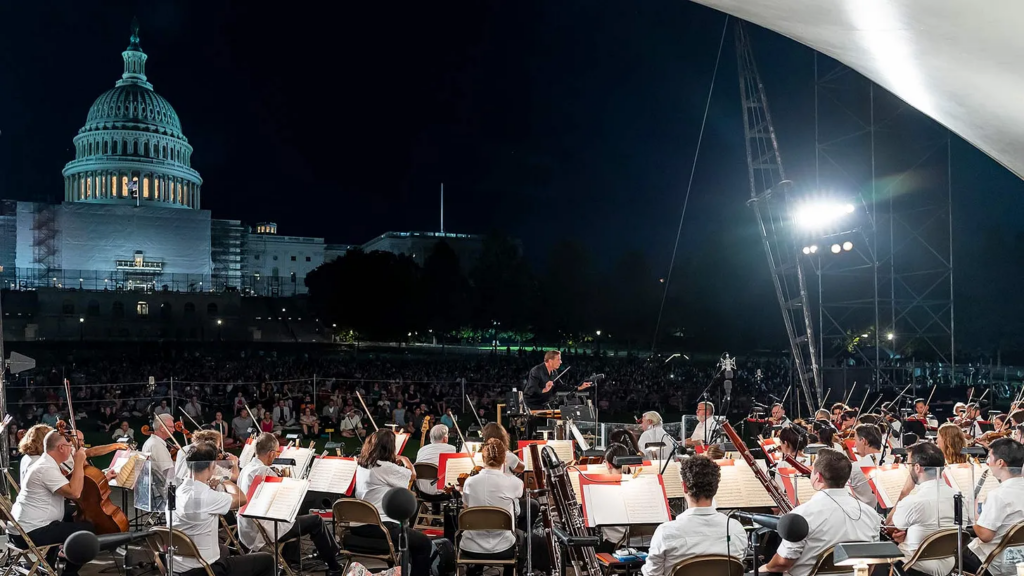
In my last post I wrote about the Cato Institute’s Ryan Bourne’s call to eliminate the National Endowment for the Arts. Here I will consider a different approach from the right, Mark Bauerlein’s “MAGA needs High Art, Not just Kid Rock”, from the New York Times. He writes about the National Endowment for the Humanities as well as the NEA, but I will focus on his thoughts about the latter (to this point, the NEH has taken some heavy cuts, but not so the NEA).
Here are some selections from the op-ed:
But for the Trump administration to promote a culture of “American greatness,” it cannot just eliminate what it dislikes; it must also support what it favors. During his first term, in a speech denouncing the “left-wing cultural revolution,” President Trump called for a more celebratory attitude toward America’s cultural heritage — one that proudly recalled that “we gave the world the poetry of Walt Whitman, the stories of Mark Twain, the songs of Irving Berlin, the voice of Ella Fitzgerald.” …
It is a conservative truism that politics are downstream from culture. What happens in the arts and humanities doesn’t stay there; it flows into the broader society over time. Without queer theory in the academy in the 1990s, the Supreme Court’s Obergefell and Bostock decisions, which extended rights and protections to gay and transgender people, might not have happened. The Trump administration needs to make sure that the right kind of culture is at the headwaters of the river today.
When it comes to popular culture, the MAGA movement readily attracts kindred spirits. Hulk Hogan speaks at the Republican National Convention. Kid Rock visits the White House. Joe Rogan presides over a sympathetic “manosphere.” But when it comes to high culture, the movement falters. After President Trump took over the Kennedy Center in February, he signaled that he would bring about a more congenial vision of the performing arts and the nation’s cultural heritage. But the people and creative works that he has mentioned in connection with this ambition — Elvis Presley, Babe Ruth, the musical “Cats” — are middlebrow at best.
This is where the N.E.H. and N.E.A. would serve Mr. Trump well: not only correcting “woke” excesses, but also providing an elite counterpart to MAGA’s populist thrust. Expert critics, scholars and artists could ensure that only traditionalist projects are funded. …
Under Mr. Gioia, the N.E.A. created Shakespeare in American Communities, which sent theater troupes into schools across the country to introduce students to the Bard. …
Ideally, the Trump administration would do more than just revive the Bush-era conception of the arts and humanities agencies. It would also draw inspiration from even bolder, New Deal-era initiatives, such as the Federal Writers’ Project, which gave jobs to out-of-work writers to document American culture, and the Federal Art Project, which funded murals, sculpture, paintings, posters and other public art.
Such ambitious proposals would be anathema to small-government Republicans, of course. And it is true that state-sponsored art programs have often resulted in clumsy propaganda. But they have also given us the Lincoln Memorial, the photographs of Walker Evans and Dorothea Lange and the great comic novel “A Confederacy of Dunces” (an N.E.A. product).
If conservatives wish to halt the progressive advance in American society, they must rectify a mistake they made decades ago: focusing on law and economics and leaving the arts and humanities to the other side.
There are more than a few things to take issue with here.
First, I think Americans in general, progressive and conservative, celebrate that this country has produced Whitman and Twain, Berlin and Fitzgerald. This is not a problem that needs fixing. At least in my town, the place you are by far most likely to hear the latter two is on our local NPR station, and it is not the Democrats who are trying to eliminate its federal subsidies.
Second, we have to keep in mind that the President of the United States is Donald Trump. His having middlebrow cultural tastes is not really the problem at the Kennedy Center; most presidents have had middlebrow taste in the arts and it’s not all that important. But look at the lackeys and sycophants he has appointed to its board and management. As in every appointment he makes, loyalty to his personal whims is paramount, with the achievement of any actual policy goal coming a distant second. In some ways Bauerlein’s piece reminds me of those tiresome articles that say “tariffs are good, actually, we just need Trump to implement them with a meticulously crafted strategy in pursuit of American industrial goals”, which as I posted in a note sometime back, is like asking my dog to perform the Hammerklavier Sonata.
Third, Bauerlein cites the familiar line “politics are downstream from culture” (I can’t quite tell if he is trying to say that rights for gay and trans people are an outcome we could have happily avoided if not for culture). But this is too simple. Politics and a broad conception of culture – in terms of how we live and what beliefs are for the most part commonly held – and a narrow conception of capital-A Art are in a very complex dynamic relationship, each affecting the other through time. Our art reflects the culture and politics of the time and place it was created much more than it changes those things. I don’t think queer theory in corners of university humanities faculty in the 1990s was much of a driver of the rights of gay people – this was a long cultural change where gay people not having rights was increasingly seen as an unjust anomaly (if I bring the conservative philosopher Michael Oakeshott into this, he would say the extension of legal protections to gays was not an example of rationalism – this was the central argument that Andrew Sullivan made in 1989). It is just not right to say “if only the art that was presented and celebrated were different, we would begin to see shifts in politics and culture.”
Which gets me to my last point. Back when I taught management and public policy, I would introduce my students to Goodhart’s Law: any variable that might have been correlated in the past with performance, that is then chosen as the metric that will be used to evaluate performance, immediately becomes useless as a metric. The individuals being evaluated will shift their priority from what they thought was important to chasing the highest possible value of the chosen metric, rendering the metric pointless.
Let me assert a similar law for the arts: while Art might influence our cultural and political values to a slight degree, any sort of art that is chosen as a vehicle for attaining specific cultural and political goals becomes debased as art and useless in fostering those goals (I would take credit for this, except that Orwell through a few essays said much the same thing). Having the NEA fund “traditionalist” projects for political purposes would quickly be recognized as such. I’m all in favor of subsidies for students to be able to attend performances of Shakespeare. But theatre is a living art, and students need to see that, embodied in new works. This doesn’t mean a focus on new works that are “relevant” to them, in the sense that “relevant” has come to mean “valuable lessons about current political issues”, which is just another form of thinking the purpose of art is to shape social attitudes. Bauerlein’s “anti-woke” agenda for the arts is as bad as any “woke” agenda, and even a fairly dull student will see right through it.
So, even if we had a normal, thoughtful conservative president, Bauerlein’s proposed agenda would fail. That we have the president we actually have for another four years, I would really prefer, for art’s sake, that he just turn a blind eye to it. If Trump took a real interest in the NEA, then I would join Ryan Bourne’s call to just put an end to it.
Cross-posted at https://michaelrushton.substack.com/


